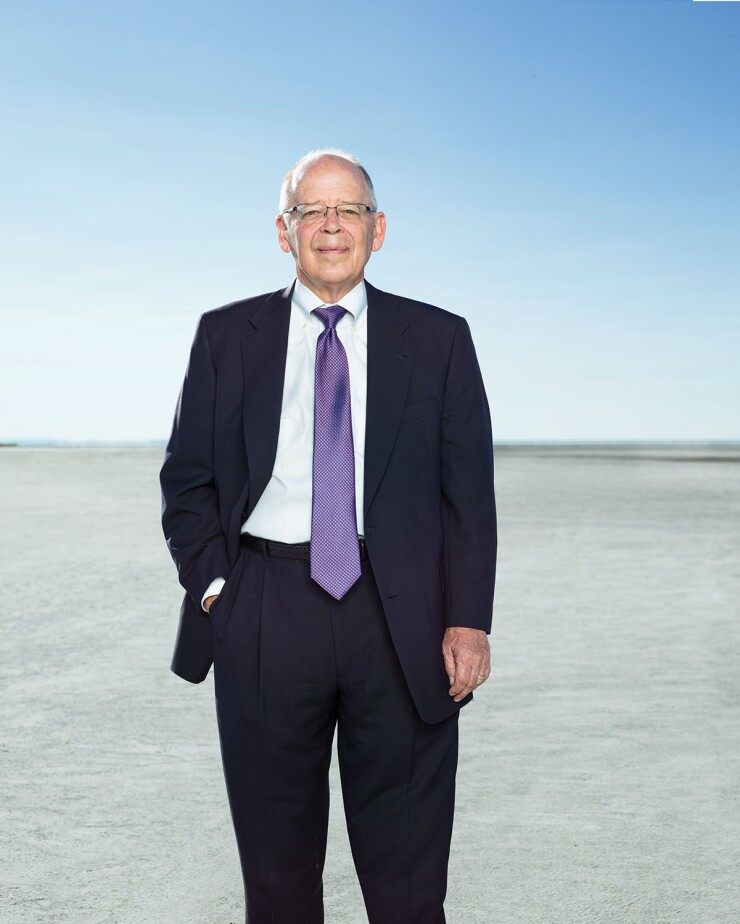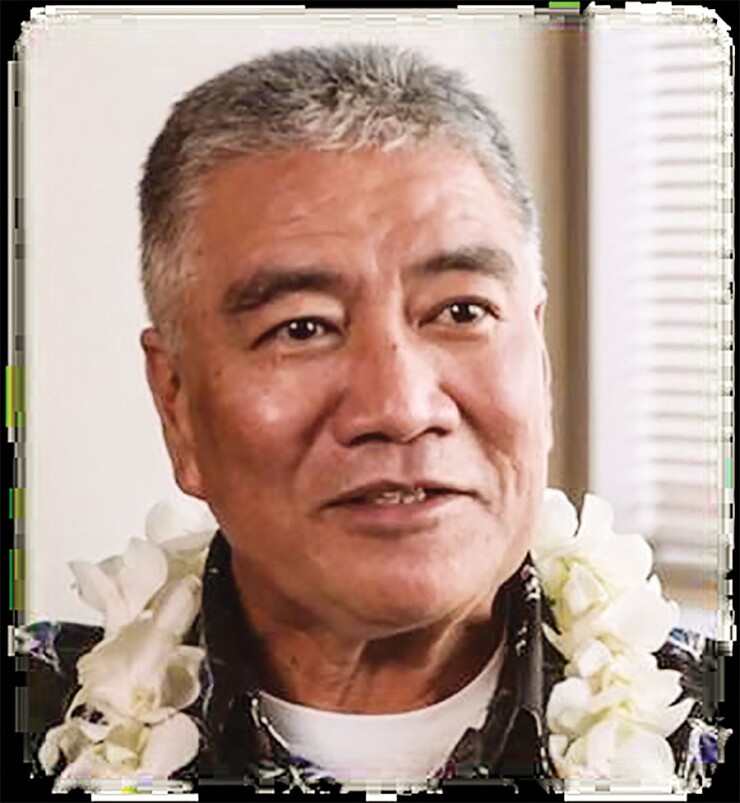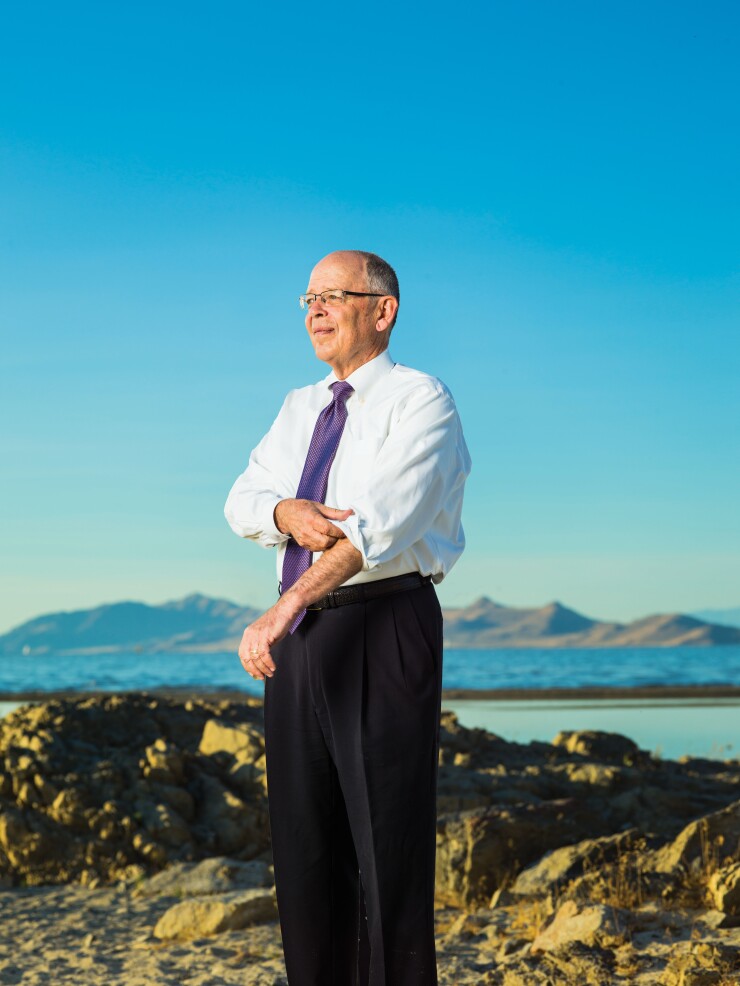Visiting American Samoa is like stepping back in time — both because of its unsullied natural beauty and its antiquated banking system.
The economy runs on cash, but until recently the island had just seven ATMs, only three of which usually worked, to serve 60,000 residents. It's common for residents to wait in line for two or three hours — sometimes queuing in the early morning before the bank opens — to cash a check. Few islanders have credit cards, and most retailers don't accept them.
American Samoa leaders have already tried to convince existing banks to open up branches there, and even attempted to form their own bank. But neither effort panned out. Now they have launched a bold effort to create a state-backed public bank, something that hasn't been done successfully in the U.S. in nearly a century. They hope it will help modernize the island's banking system — and American Samoa itself.
"There is a great need for basic banking services in American Samoa, because they are not being served right now," said Phil Ware, a longtime Utah banker who is president of the newly created Territorial Bank of American Samoa. "I mean basic needs, like supplying cash, offering checking accounts and offering credit/debit cards. Our whole bank is a CRA [Community Reinvestment Act] project."

Yet the outcome is by no means certain. The Territorial Bank took a major step forward last year by opening its doors and offering islanders limited services.
But it still needs a key regulatory approval to provide even checks to its customers and to make good on the hopeful vision of island leaders and bank executives. If U.S. regulators do not act soon, the endeavor could fall apart, leaving the island without any prospect for a solution in the foreseeable future.
"American Samoa is the truest form of banking — there is a definite need," said Robert Ho Chee, a banking industry veteran and island native who was hired to be American Samoa's regulator and run its new Office of Financial Institution.
'That's just how it is'
This is the story of a bank in limbo, one whose future could reshape American Samoa.
Though the Territorial Bank of American Samoa has received no attention stateside, it is at the nexus of several policy debates, including the high requirements demanded of new entrants to the banking system and how best to bring underbanked consumers into the financial system.
But the leaders of the bank aren't interested in breaking new ground for the industry. They are worried only about the island itself.
American Samoa remains left behind from the technological changes that have fundamentally altered banking over the past few decades. More than half of the households on the island are at, near or below the U.S. federal poverty level, according to the most recent census statistics. The majority of American Samoa qualifies as low- to middle-income under the CRA.
Those who work for the bank are hopeful that the institution could help improve that situation.
"One of the initiatives is to get them into the 20th century, never mind the 21st century," said Drew Roberts, a Utah-based banking consultant who was brought in to help set up the bank.
When he first arrived on the island, he was struck by what he saw at the branches of the two banks then still operating in the territory.
"There was a line of cars outside the bank, and people around the block," he said. "That's a 1929-type run on a bank."
But it wasn't a run, just people waiting to be served. "That's just how it is," he said.
A crisis in the making
American Samoa is one of the United States' most far-flung — and forgotten — U.S. territories.
Acquired by the U.S. in 1899 as part of a deal with Germany and Great Britain, it operates in a nebulous area somewhere between statehood and independence. It has its own democratically elected legislature and governor, but all laws must be approved by the U.S. president, who retains the power to dissolve the legislature. Its people are not American citizens, but American nationals, with the right to live and work in the states. It is one of only two U.S. properties in the southern hemisphere, with the other being the uninhabited Jarvis Island.
Despite this, American Samoa has the sixth-highest rate of enlistment in the U.S. armed forces per capita of any state or territory. That is at least partly because of a lack of economic opportunity on the island. American Samoa has only two main industries: tuna fishing and tourism.
The island's modern banking history has been centered on two institutions: Bank of Hawaii and ANZ.
But Bank of Hawaii, which had done business in the territory since 1969, shocked the island's government when it announced in late 2012 that it was pulling out of the island, citing American Samoa's "geographic isolation" from its other markets.
"Bank of Hawaii was so dominant over here and such a good bank," said Chee, who formerly worked for Bank of Hawaii both on and off American Samoa.
American Samoa pressured Bank of Hawaii to remain on the island for a few years until it could find a successor institution, though the bank wouldn't stay indefinitely.
Finding another bank to take its place has been difficult. The government sought out other institutions that might want to have branches on the island, but any takers face logistical problems that are hard to overcome.

The chain of islands that make up the territory have roughly the same geographic footprint as Washington, D.C., but only a tenth of that city's population. It is thousands of miles away from the nearest other U.S. territory, with only two flights a week in or out. Just getting cash to fill up the ATMs is challenging. Internet service has been billed "the most expensive in America."
"We went to all the banks in Hawaii — and also tried some banks in the states — but none were interested," said Iulogologo J. Pereira, executive assistant to American Samoa Gov. Lolo Matalasi Moliga.
Eager to solve the problem, private investors in American Samoa tried to create a de novo of their own. Though they raised capital and applied to regulators for approval, that effort ultimately failed. It's been nearly impossible since the financial crisis to charter a de novo institution. Many industry observers say the Federal Deposit Insurance Corp.'s standards are too high, though federal regulators attribute the drought to a lack of demand.
That left just the Australian bank ANZ willing to remain in the territory. It serves American Samoa from its "local" headquarters in Guam, more than 3,500 miles away, and it was unwilling to significantly step up its presence on the island, though it recently expanded to 10 ATMs.
"All the lending and everything else goes out of Guam," Pereira said. "It doesn't give us a relationship to help develop the economy."
With no bank willing to take over for the departing Bank of Hawaii, and the regulatory demands too high to form a privately owned institution, officials in American Samoa were struggling for an answer.
They found one in an unlikely place: the rural, landlocked state of North Dakota.
A public bank
The Bank of North Dakota is unique in American history. Formed in 1919 in response to an agricultural crisis, it is not backed by the FDIC, but instead is run and supported by the state itself. Though other states formed public banks in the distant past, the Bank of North Dakota is the only one still operating.
By law, the state of North Dakota deposits its tax revenues in the bank, and those funds are used to offer cheap agricultural, energy, and student loans to local businesses and consumers.
The bank is widely regarded as a success, straddling the line between offering banking services while not seeking to compete directly with private institutions. The $7 billion-asset Bank of North Dakota works with 100 bank partners, provides only limited checking accounts to customers and has no branches.
"We're not really competing with the private sector, but complementing them," said Eric Hardmeyer, president of the Bank of North Dakota.
Though any resident of North Dakota can open a checking account at the bank, doing so is a no-frills experience. The bank doesn't even offer debit cards.
"We're not trying to be everything to everybody," Hardmeyer said. "We're the financiers of economic development for the state of North Dakota. We are really here to make North Dakota better."
The bank has been profitable, earning record gains for the past 13 years, according to Hardmeyer. The profits go back to the state budget.
American Samoa officials saw an opportunity in the Bank of North Dakota's model, a way to sidestep the need for an FDIC sign-off while still allowing for a full-fledged banking institution.
"We wanted to find a model that reflects our uniqueness. The only model that is out there is the Bank of North Dakota," Chee said. "They are the epitome of what it's like to be a community bank at the state level."
Public banks are more common in the rest of the world, particularly developing countries.
"Quite often the public banks are the ones who are banking the poor, or bringing banking services outside of the major centers," said Thomas Marois, senior lecturer of development studies at the University of London, who has studied public banks.
But state-run banks are anathema to the American character. Despite renewed efforts in states like New Jersey to form one, the model is vigorously opposed by the banking industry and conservatives, who view state-run enterprises as government intrusion in the market.
Even American Samoa officials are reluctant supporters of the idea.
"The government doesn't like to get into the private-sector business," Pereira said. "There was no other alternative."
There are two potential pitfalls to public banks. The first is opposition from private institutions who fear competing with a government-backed institution, an issue that simply isn't relevant for American Samoa.
The second is more of a concern: that a public bank may become too intertwined with the government that's supporting it.
To head off that worry, American Samoa officials have built a Chinese wall between the territory and the bank. Though its board members are nominated by the governor and confirmed by the Fono, the territory's legislature, the relationship stops there.
"Once that is done, the government has no say in the running of the bank," Pereira said.
The bank cannot lend to its board members or to the government.
"We built as many buffers as we could to keep the government influence directly or indirectly out of the bank," Ware said. "We've been very careful to design it like that."
Waiting for the Fed
A tremendous amount of work has already gone into setting up the Territorial Bank of American Samoa.
Legislation was approved in February of last year to fund the bank via a bond issue. It formally opened its doors in October, using branches donated to it by the Bank of Hawaii, which finally departed the island at that time. Island leaders created a regulatory agency, the Office of Financial Institution, and hired Chee, a 23-year banking veteran, to run it. They sought out help from Roberts and Ware in Utah.
The bank is backed with more than $12.5 million in capital and has already taken in $1.7 million in deposits, according to its first-quarter financial statement.
Demand is clearly not a problem. At the bank's opening ceremony — which featured a speech from the governor — the lobby was packed with customers. Even months later, the bank was opening 12 to 15 deposit accounts a day, according to Ware.
Yet for all that, the bank is missing a crucial piece, and that threatens to doom the entire enterprise unless it is granted soon: access to the payment system.
It is the key to being able to transact with other U.S. institutions and offer basic services that the rest of the country takes for granted. Without it, the bank is unable to offer traditional amenities to customers, such as checks. It has to use a third-party service to offer customers their own debit card.
Those services are essential. Currently, there is no way for residents of American Samoa to obtain a credit card without going off the island, which can be prohibitively expensive to do. Technically, the Territorial Bank can offer loans without a transit number, but it's harder without the connection to the payment system. That has left American Samoans prey to so-called backyard lenders.

Without access to the payment system, the Territorial Bank can't even turn to other U.S. institutions as correspondent banks to help wire money or take other basic steps.
The Territorial Bank applied to the American Bankers Association last July for a transit routing number, which would make it part of the payment system. But winning that approval requires the Federal Reserve to sign off that the bank is eligible for central bank services. Despite months of waiting, that has yet to happen.
For the Fed, the case is unusual. It's a state-backed public bank without FDIC insurance in a small geographic area with an overwhelmingly poor population. Fed officials are wary of government ties to the Territorial Bank, according to public testimony by bank executives.
But those executives believe they've addressed the substantive issues. Island leaders and bank officials have held lengthy discussions with the Federal Reserve Bank of San Francisco, which has sent the case to the Federal Reserve Board to review given the unusual circumstances. American Samoa's governor met with Fed General Counsel Scott Alvarez in February of this year to discuss the application.
Since then, it's been a waiting game.
"We've got the system, got the building, got the people," Ware said. "Everything is in place to offer all of this, but we can't do it, because we're not part of the payment system. ...
"That is very frustrating."
It's not clear when or even if the Fed will act. A Fed spokesman declined to comment.
For their part, bank executives and Chee are confident that it's only a matter of time. If the approval does come through, Ware, who currently splits his time between Utah and American Samoa, plans to move to the island permanently.
He estimates it will take the bank less than a month after getting the approval to start offering more services.
"We'll have everything lined up and ready to go — we will be a bank after that," Ware said.
It's difficult to overstate just how important this approval is to the bank. In interviews, it is invoked repeatedly by government officials and bank executives, who clearly are waiting on tenterhooks for it to happen.
"This is the linchpin," Roberts said. "That has to happen. Once it does, all the doors open. The world changes for American Samoa."
Future plans
Bank executives have big plans if and when the approval comes through. For one thing, rather than running a public bank in perpetuity, they are hoping in a few years it can be sold into private hands and obtain FDIC insurance, two separate transactions that would likely have to come at the same time. That would enable American Samoa to have a private community bank all of its own.
Bank executives said they already have an interested group of investors — the same ones that tried to form a bank earlier. But the Territorial Bank will need to show it can run profitably first.
Persuading the FDIC to grant deposit insurance will be its own challenge. The FDIC is unlikely to approve deposit insurance for a state-run bank. It last issued guidance on the subject nearly 20 years ago, and though it did not specifically ban the concept, it expressed significant reservations.
The hope is that once the Territorial Bank can prove itself, the FDIC will look more favorably on granting insurance, particularly if private investors are willing to take it out of government control.
"The intention is to run the bank for two or three years to make sure we eliminate all the problems," Pereira said. "So they have a track record for the FDIC to judge."
Roberts said the bank will ensure it follows requirements of other FDIC-insured banks to make getting deposit insurance easier. "This will be run as if it were an FDIC institution," he said. "Same reports, same structure. All of that will be as if it is an FDIC bank."
Beyond that, Chee has an even grander ambition. He is hoping that once the Territorial Bank is successful, other institutions will see there's opportunity on the island, despite the challenges of branching there. To that end, his agency has joined the Conference of State Bank Supervisors and he's been in meetings around the mainland in an attempt to drum up interest.
"This little bank is the impetus for us to be noticed by the rest of the world so other banks can come in," he said. "For us, it's a necessary stopgap to get things going."
But all agree that those goals are for the future. For now, the focus is on winning the Fed approval, and making the bank a full-service one. Once that happens, they feel confident they can deliver on a promise to islanders to give them what consumers in the rest of America already have.
"The bank isn't there to make money. It's there to provide services to the American Samoan people," Roberts said. "The whole idea is to find the mechanisms so that people in American Samoa can live their lives like people in Portland."





